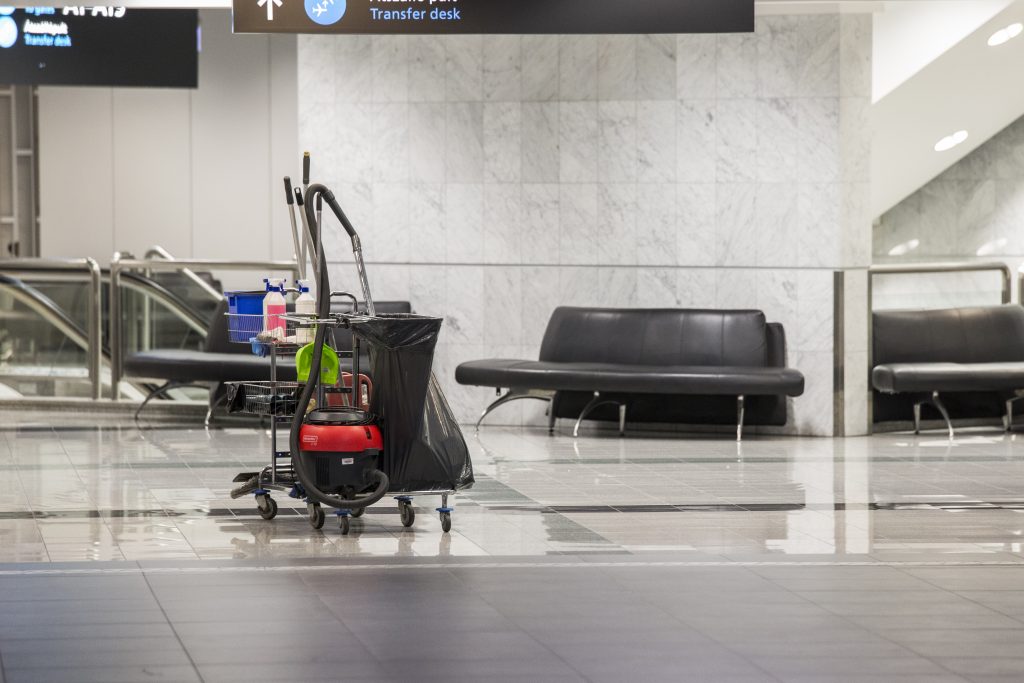FMnewsroom – professional cleaning. Every environment should have equipment that is fit for purpose, thus there is no such thing as a typical trolley. The requirements of a trolley will depend on the area of application and the context in which it is used. It simply needs to be equipped with the right set of items and products required for carrying out the cleaner’s work, just as a van needs to accommodate the tools of an operator’s trade, as the European Cleaning Journal puts it.
Adaptability is a must
Buckets, a wringer, trays and a bag holder are among a cleaning trolley’s most essential components, along with drawers, a lockable door and a holder for the mopping system. However, there is increasing demand for trolleys that can be adapted to the working environment and customers’ special needs.
„Today’s market is also seeking a high level of functionality along with customisable products. And if a trolley is modular, that’s also a plus because it means it can easily be adapted to suit the customer’s needs.”- Greenspeed’s digital trade marketer Eva Meerts points out.
“Being able to accessorise a basic trolley layout gives the customer the ability to fine-tune their own configuration” – Crisp Clean’s sales manager Keara Page adds, highlighting that they are using a system which allows customers to stay involved at every stage of the process from initial concept to prototype development.
There is no one trolley fits all
Each environment has its specific requirements when it comes to trolleys or carts. However, three main locations that can easily be distinguished according to customer needs, flooring and hygiene requirements are offices, hotels and hospitals.
Offices
Experts agree that in offices with corridors, narrow passages and lots of furniture your trolley will need to be easy to manoeuvre and should take up as little space as possible. Office trolleys also need to accommodate surface cleaners and dusters as well as floor cleaning equipment such as pre-impregnated mops or a double bucket and wringer.
Hospitality
In a hotel, the trolley should be discreet and unobtrusive while capable of facilitating room cleaning and linen collection. They also need to incorporate waste collection, dusting and wet mopping functions and be designed to help staff members prepare guest rooms quickly, easily and discreetly. Design is also in focus, as hotel trolleys should be aesthetically pleasing as well.
Kärcher’s product manager, Beyza Gügercin claims a hotel trolley’s main requirements are that they should be easy to push when fully loaded. It should also have large wheels and flat shelves to accommodate linen and towels as well as trays for holding amenities items. And a hotel trolley cant miss to have a lateral bag support to contain rubbish or dirty laundry.
Healthcare
Probably the most scrupulous eyes are on the hospital trolleys as they have to be hygienic and handy at the same time. This is why it is of utmost importance that trolleys in hospitals should be easy to clean and disinfect and constructed to help prevent the risk of contamination between the washing, storage and waste collection areas.
Experts agree that a hospital should be served by a flexible, closed trolley with multiple compartments and lockable doors for hygiene and safety reasons, with wheels designed to prevent the accumulation of dirt and can also be disinfected between uses.
“For example, the ideal hospital trolley configuration would incorporate a pre-impregnation system for mops to ensure the correct disinfection process. And a hotel trolley will have specific storage requirements because it will need to be able to accommodate clean sheets.”- IPC’s product manager for tools Elisa Marcon points out.
According to Keara Page a hospital trolley needs to be equipped with a double bucket wringer system or a dosing system using a clean mop for every 10 to 20 square metres. And in public areas, it is important trolleys don’t become an eyesore and that all harmful chemicals are secured out of view. She also claims that a healthcare trolley requires a segregated waste collection system.

Trolleys must meet the needs of changing times
The professionals asked by the European Cleaning Journal agree that the two greatest drivers for change are technological innovation and today’s more stringent hygiene requirements.
Covid-19 has required manufacturers to adopt new approaches and take stricter hygiene measures. And operators are increasingly demanding new tools to help them manage and organize their work as technology gains ground in the professional cleaning sector – Filmop’s Paolo Scapinello points out.
Beyza Gügercin also adds that demands for enhanced productivity are a major driver for change. “It is becoming increasingly important for users to be able to save time and boost productivity by transporting multiple machines on their trolleys. For example, they might need to incorporate vacuum cleaners, scrubber dryers or battery-operated window washers on their trolleys to cut down on unnecessary journeys to the cleaning storage room.


